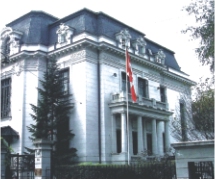Cool, calm and eclectic
 At Canada's representative office, Anca Pol investigates a distinguished interwar villa and former ministerial residence with a secret hideaway in the basement, where the moose is on the loose
At Canada's representative office, Anca Pol investigates a distinguished interwar villa and former ministerial residence with a secret hideaway in the basement, where the moose is on the loose
At the busy junction of Piata Romana the first thing one notices is a lack of signposts and street-names and a general disaffection among the pedestrians, which means the prospect of getting lost is almost assured. But if one asks any passer-by for the location of the Canadian Embassy, one will be greeted quickly with a hand pointing in the direction of 36 Nicolae Iorga St.
Almost everyone knows this place, because nearly all Romanians have a cousin or a cousin's cousin who has entered its Immigration Building hoping to gain a visa to the large and spacious north American territories.
As opposed to the urban rush of Magheru Boulevard, a visitor to the nearby embassy finds themselves in a tranquil and leafy area. Here there are three separate blocks, the Embassy's main building, with the press and cultural departments and an information centre for investors, the immigration building and an appendix building containing the Canadian International Development Agency.
A whitewashed construction with an eclectic design, the main building differs from the other numerous interwar architecture of Romania's capital with a mix of deco and art nouveau flourishes given a local edge. Under close examination, the building shows its true colours: unlike this rich French eclectism, such as the headquarters of national savings bank CEC on Calea Victoriei, the main building of the Canadian Embassy is British eclectic, more simple and sober, due to its straight-line frames, with quasi-baroque decorations added only to the upper part of the building. Finally, using a Romanian interwar leitmotif, there is a glass and steel-shell shaped canopy built above the main entrance.
On the ground floor, one is greeted by the portraits of Canada's present governor and prime minister, before going up a beautiful dark wooden staircase, where, like elegant wardens, the flags of Canada's ten provinces and three territories stand to attention on the steps. To further push home the theme, other signs of Canadianicity were hung on the tall walls of the staircase: such as a portrait of a member of the Royal Canadian Mounted Police (but minus his steed) and a pretty sketch by J. Sharkey Thomas of a marmot family.
Treasures on the first floor include a wide stained glass window created in French town Billancourt by the Romanian artist Duiliu Marcu which shows an industrial vista of mines and factories in mellow autumn tones. This is alleged to be the property of one of the house's reported former owners, 1940s Romanian Prime Minister Ion Gigurtu.

The first floor is also the headquarters of the Canadian Ambassador. “What is my favourite place in the Embassy? My office, of course,” Mr. Franco D. Pillarella tells The Diplomat without any second thought.
There are also other visitor-friendly spots to the house. Among them, the popularity prize goes to The Moosehead, a snug little pub nesting in the basement of the adjacent building. Containing a little room, cosy tables, a bar with draft beer served by the staff members and a dart-board with markings for the amateur and professional dart thrower, The Moosehead is a stress-free area where the Canadian hosts and their friends gather over a glass of Christmas moosemilk: Not the lactations from a large woodland mammal, but a cocktail of rum, kahlua and vanilla ice cream.
In 2001 a new annex was built, the Immigration Building. This is a modern response to contemporary needs and the construction contrasts with the eclectic main building, but maintains a friendly and accessible continuity. So much so, that this lures hundreds of Romanians every year to pass through the lengthy and quite costly process of gaining a long-term visa for Canada. On entering the first floor of the building, one is greeted by dozens of chairs, with many pairs of eyes gazing upwards with a mix of worry and high expectation, grasping files and papers in their hands, waiting for their visa interviews.

Outside is a small courtyard with an Italian terrace. April evenings are still chilly, but summer's not far behind, which means that the staff of the Embassy will soon bring their Moosehead fun outside.
But most probably, it is the last summer they will spend at 36 Nicolae Iorga, as the Embassy is due to move to a new building this autumn in the Kiseleff area.